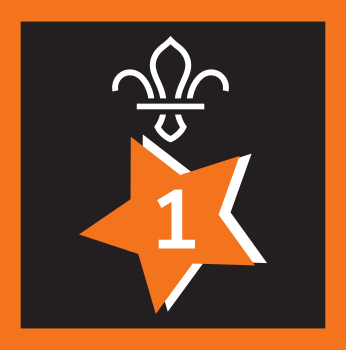Hop in
You’ll need
- Pens or pencils
- A4 paper
- Something to mark lines (for example, chalk, masking tape, or rope)
Before you begin
- This game may work best at the end of the year in July or December, when a lot of young people will have just completed another year in Scouts.
- Use the chalk or masking tape to mark out 12 large squares in a line. Each square should be big enough for two people to stand in.
- You’ll need to plan 12 challenges, one for each square.
- Write or draw each challenge, and put one in each square (along with any equipment needed).
Explain the award
- The person leading the game should ask if anyone remembers what the Joining In Award is, and how people earn them. Everyone should share their ideas – some people may be able to find an example of the award on their uniforms.
Play the game
- Everyone should split into two teams.
- The two teams should line up next to each other. Everyone should face the first square.
- The first player in each team should hop into the first square. They should complete the challenge in the square. As soon as they’ve finished the challenge, they should hop into the next square. They should move through all 12 squares, completing the challenge then hopping on.
- Once the first player in a team has completed four challenges (so they’re in the fifth square), the second player in the team should hop into the first square, and repeat step three.
- Everyone should repeat steps four and three: Once the person in front of them completes four challenges (and reaches the fifth square), they should hop into the first square and begin to complete a challenge and hop on.
- Everyone not on the squares should encourage their teammates. They may be able to offer hints or help.
- The winning team is the first to get everyone through all 12 squares.
Possible challenges
- Name something you’ve promised to do as part of the Beaver Scout Promise.
- Mime playing your favourite game.
- Say hello in a language other than English.
- Do ten star jumps.
- Build a pyramid out of six cups.
- Close your eyes, stand on one leg, and clap three times.
- Make the Scout sign at someone. Don’t move on until they make the sign back.
- Tie a knot in a piece of rope.
- Name three people in your Colony.
- Name a flag that has red, white and blue on it.
- Name something you might take camping.
- Name three things a pet needs to stay healthy.
- Pretend to walk up a very steep hill.
- Tell everyone your favourite badge.
- Build a tower with six blocks (and knock it down before you move on).
Reflection
This game needed everyone to keep on going, even if the challenges were tricky. Different people probably found different challenges trickier than others - just like all of the other activities everyone does together. Just like with other activities, there were plenty of people to help each other.
Everyone should think about their teammates. How did their friends help them keep going? Everyone should also think about how they kept going. What are people looking forward to doing over the next year?
Do they think some of the activities might be difficult? It’s important to learn to push through challenges, and get back up and try again if needed. There’s no rush - and no one is in it alone. At Scouts, everyone plays their part to help their friends succeed. Well done to everyone who gave the challenges a go.
Safety
All activities must be safely managed. You must complete a thorough risk assessment and take appropriate steps to reduce risk. Use the safety checklist to help you plan and risk assess your activity. Always get approval for the activity, and have suitable supervision and an InTouch process.
- Active games
The game area should be free of hazards. Explain the rules of the game clearly and have a clear way to communicate that the game must stop when needed. Take a look at our guidance on running active games safely.
Make the challenges easier or harder depending on your group. You may want to create some harder challenges for more experienced players.
You could make the fifth square a different colour, or colour it in, to make it obvious when the next person needs to start. This way, there’s no counting involved.
Make sure all of the activities are accessible for everyone. You may need to avoid physical or spelling challenges, for example, depending on the needs of the group.
All Scout activities should be inclusive and accessible.
This could also be a great way to introduce people to your group. Why not pair it with other activities that count towards the Membership Award? You could also use it to burn off some energy before a log chew, and get everyone thinking about the activities they enjoy and want to do more of.
Encourage people to design the challenges for themselves – each team could create six each.
